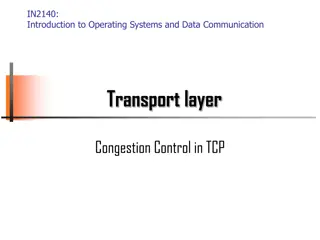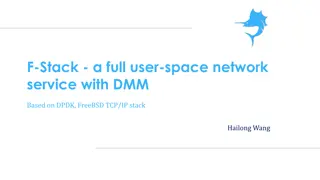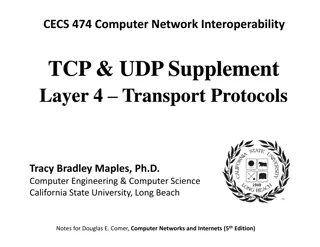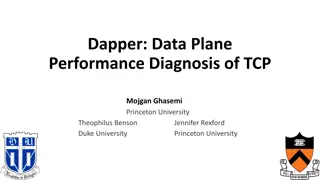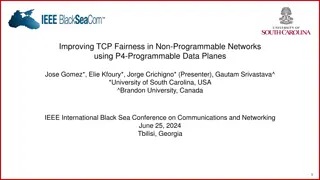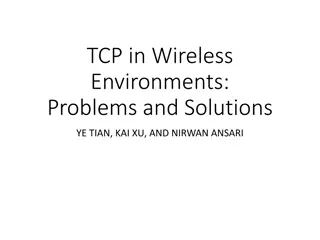
Overview of TCP Protocol in Networking
Learn about TCP (Transmission Control Protocol) which provides connection-oriented, reliable byte stream communication through features such as multiplexing, flow control, congestion control, and more. Understand the essential components of TCP headers and its role in ensuring data reliability and order in network transmissions.
Download Presentation

Please find below an Image/Link to download the presentation.
The content on the website is provided AS IS for your information and personal use only. It may not be sold, licensed, or shared on other websites without obtaining consent from the author. If you encounter any issues during the download, it is possible that the publisher has removed the file from their server.
You are allowed to download the files provided on this website for personal or commercial use, subject to the condition that they are used lawfully. All files are the property of their respective owners.
The content on the website is provided AS IS for your information and personal use only. It may not be sold, licensed, or shared on other websites without obtaining consent from the author.
E N D
Presentation Transcript
Connection-oriented, point-to-point protocol: Connection establishment and teardown phases Phone-like circuit abstraction (application-layer view) One sender, one receiver Called a reliable byte stream protocol General purpose (for any network environment) 2
TCP provides the following facilities to Stream Data Transfer: Transfers a contiguous stream of bytes in TCP segments Multiplexing: allow for many processes within a single host to use TCP communication facilities simultaneously. Reliability Flow Control and congestion control Originally optimized for certain kinds of transfer: Telnet (interactive remote login) FTP (long, slow transfers) Web is like neither of these! Originally optimized for wired networks 3
application writes data application reads data socket layer socket layer TCP TCP data segment receive buffer send buffer ACK segment Provides a reliable, in-order, byte stream abstraction: Recover lost packets and detect/drop duplicates Detect and drop corrupted packets Preserve order in byte stream; no message boundaries Full-duplex: bi-directional data flow in same connection Flow and congestion control: Flow control: sender will not overwhelm receiver Congestion control: sender will not overwhelm the network Sliding window flow control Congestion control done via adaptive flow control window size Send and receive buffers 4
32 bits SrcPort and DstPort: These two fields plus the source and destination IP addresses, combine to uniquely identify each TCP socket Sequence number: the byte in the stream of data from the sending TCP to the receiving TCP that the first byte of data in this segment represents Acknowledgement number: contains the next sequence number that the sender expects to receive. This acknowledges receipt of all prior bytes. This field is valid only if the ACK flag is on. source port # sequence number acknowledgement number F S R P A U len used dest port # head not rcvr window size ptr urgent data checksum Options (variable length) application data (variable length) 5
32 bits Header length: gives the length of the header in 32-bit words Flags (6 bits): URG this segment contains urgent data. When this flag is set, the UrgPtr field indicates where the non-urgent data contained in this segment begins ACK indicates that the Acknowledgment field is significant. All packets after the initial SYN packet sent by the client should have this flag set. PSH Push function. Asks to push the buffered data to the receiving application. RST Reset the connection SYN Synchronize sequence numbers. Only the first packet sent from each end should have this flag set. FIN No more data from sender source port # sequence number acknowledgement number F S R P A U len used dest port # head not rcvr window size ptr urgent data checksum Options (variable length) application data (variable length) 6
32 bits Not used: for future use and should be set to zero Receive window: the number of bytes that the receiver is currently willing to receive Checksum: The 16- bit checksum field is used for error-checking of the header and data Option field: has many different options. For example MSS (maximum segment size) option, which specifies the maximum sized segment the sender wants to receive. source port # sequence number acknowledgement number F S R P A U len used dest port # head not rcvr window size ptr urgent data checksum Options (variable length) application data (variable length) The data portion of the TCP segment is optional. 7
The 3-way handshake : Client sends SYN with initial sequence number (ISN = X) Server responds with its own SYN w/seq number Y and ACK of client ISN with X+1 (next expected byte) Client ACKs server's ISN with Y+1 X, Y randomly chosen All modulo 32-bit arithmetic client server connect() listen() port 80 time accept() read() 8
application writes data application reads data socket layer socket layer TCP TCP data segment receive buffer send buffer ACK segment Sender TCP passes segments to IP to transmit: Keeps a copy in buffer at send side in case of loss Called a reliable byte stream protocol Sender must obey receiver advertised window Receiver sends acknowledgments (ACKs) ACKs can be piggybacked on data going the other way Protocol allows receiver to ACK every other packet in attempt to reduce ACK traffic (delayed ACKs) Delay should not be more than 500 ms (typically 200 ms) We will see how this causes problems later 9
Three way handshake 1629.884415 192.168.1.9 -> 136.159.5.17 44 TCP 1035 80 133227 : 133227 0 win: 32768 S 1629.886713 136.159.5.17 -> 192.168.1.9 44 TCP 80 1035 3310607972 : 3310607972 133228 win: 24820 SA 1629.888507 192.168.1.9 -> 136.159.5.17 40 TCP 1035 80 133228 : 133228 3310607973 win: 32768 A Timestamp Src IP Dst IP IP pkt size Protocol SrcPort DstPort Seq num ACK num win size flag 1629.948462 192.168.1.9 -> 136.159.5.17 418 TCP 1035 80 133228 : 133606 3310607973 win: 32768 PA 1629.952320 136.159.5.17 -> 192.168.1.9 40 TCP 80 1035 3310607973 : 3310607973 133606 win: 24820 A 1629.955295 136.159.5.17 -> 192.168.1.9 329 TCP 80 1035 3310607973 : 3310608262 133606 win: 24820 PA 1629.959145 136.159.5.17 -> 192.168.1.9 1500 TCP 80 1035 3310608262 : 3310609722 133606 win: 24820 A 1629.960963 136.159.5.17 -> 192.168.1.9 1500 TCP 80 1035 3310609722 : 3310611182 133606 win: 24820 PA 1629.962090 192.168.1.9 -> 136.159.5.17 40 TCP 1035 80 133606 : 133606 3310609722 win: 31019 A Data transmission 10
Sender may not only overrun receiver, but may also overrun intermediate routers: No way to explicitly know router buffer occupancy, so we need to infer it from packet losses Assumption is that losses stem from congestion, namely, that intermediate routers have no available buffers Sender maintains a congestion window: Never have more than CW of un-acknowledged data outstanding (or RWIN data; min of the two) Successive ACKs from receiver cause CW to grow. CW grows based on one of 2 phases: Slow-start: initial state. Congestion avoidance: steady-state. Switch between the two when CW > slow-start threshold 11
Lack of congestion control would lead to congestion collapse (Jacobson 88). Idea is to be a good network citizen . Would like to transmit as fast as possible without loss. Probe network to find available bandwidth. In steady-state: linear increase in CW per RTT. After loss event: CW is halved. This general approach is called Additive Increase and Multiplicative Decrease (AIMD). Various papers on why AIMD leads to network stability. 12
Initial CW = 1. After each ACK CW += 1; Continue until: Loss occurs OR CW > slow start threshold Then switch to congestion avoidance If we detect loss, cut CW in half Exponential increase in window size per RTT sender receiver RTT time 13
Until (loss) { after CW packets ACKed: CW += 1; } ssthresh = CW/2; Depending on loss type: SACK/Fast Retransmit: CW /= 2; continue; Course grained timeout: CW = 1; go to slow start (This is for TCP Reno/SACK: TCP Tahoe always sets CW=1 after a loss) 14
Coarse-grained Timeout: Sender does not receive ACK after some period of time Event is called a retransmission time-out (RTO) RTO value is based on estimated round-trip time (RTT) RTT is adjusted over time using exponential weighted moving average: RTT = (1-x)*RTT + (x)*sample (x is typically 0.1) sender receiver timeout X loss First done in TCP Tahoe time lost ACK scenario 15
Receiver expects N, gets N+1: Immediately sends ACK(N) This is called a duplicate ACK Does NOT delay ACKs here! Continue sending dup ACKs for each subsequent packet (not N) sender receiver X Sender gets 3 duplicate ACKs: Infers N is lost and resends 3 chosen so out-of-order packets don t trigger Fast Retransmit accidentally Called fast since we don t need to wait for a full RTT time 16
Either side may terminate a connection. (In fact, connection can stay half- closed.) Let's say the server closes (typical in WWW) client server close() Server sends FIN with seq Number (SN+1) (i.e., FIN is a byte in sequence) Client ACK's the FIN with SN+2 ("next expected") close() Client sends it's own FIN when ready Server ACK's client FIN as well with SN+1 time timed wait closed 17
TCP uses a Finite State Machine, kept by each side of a connection, to keep track of what state a connection is in. State transitions reflect inherent races that can happen in the network, e.g., two FIN's passing each other in the network. Certain things can go wrong along the way, i.e., packets can be dropped or corrupted. In fact, machine is not perfect; certain problems can arise not anticipated in the original RFC. This is where timers will come in, which we will discuss more later. 18
CLOSED CLOSED: more implied than actual, i.e., no connection LISTEN: willing to receive connections (accept call) SYN-SENT: sent a SYN, waiting for SYN-ACK SYN-RECEIVED: received a SYN, waiting for an ACK of our SYN ESTABLISHED: connection ready for data transfer server application calls listen() client application calls connect() send SYN LISTEN SYN_SENT receive SYN send SYN + ACK receive SYN send ACK receive SYN & ACK send ACK SYN_RCVD receive ACK ESTABLISHED 19
ESTABLISHED FIN-WAIT-1: we closed first, waiting for ACK of our FIN (active close) FIN-WAIT-2: we closed first, other side has ACKED our FIN, but not yet FIN'ed CLOSING: other side closed before it received our FIN TIME-WAIT: we closed, other side closed, got ACK of our FIN CLOSE-WAIT: other side sent FIN first, not us (passive close) LAST-ACK: other side sent FIN, then we did, now waiting for ACK close() called send FIN receive FIN send ACK FIN_WAIT_1 receive FIN send ACK receive ACK of FIN CLOSE_WAIT close() called send FIN FIN_WAIT_2 CLOSING receive FIN send ACK receive ACK of FIN LAST_ACK TIME_WAIT receive ACK wait 2*MSL (240 seconds) CLOSED 20
Protocol provides reliability in face of complex network behavior Tries to trade off efficiency with being "good network citizen (i.e., fairness) Vast majority of bytes transferred on Internet today are TCP-based: Web Email News Peer-to-peer (Napster, Gnutella, FreeNet, KaZaa) Some video streaming applications (YouTube) 21




